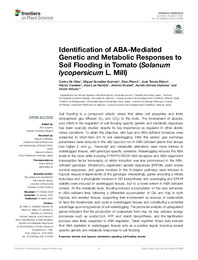Título :
Identification of ABA-Mediated Genetic and Metabolic Responses to Soil Flooding in Tomato (Solanum lycopersicum L. Mill) |
Autor :
de Ollas, Carlos 
Gonzalez-Guzman, Miguel 
Pitarch, Zara
Matus, José Tomás 
Candela, Héctor
Rambla, José L. 
Granell, Antonio 
Gomez-Cadenas, Aurelio 
Arbona, Vicent  |
Editor :
Frontiers Media |
Departamento:
Departamentos de la UMH::Biología Aplicada |
Fecha de publicación:
2021-03-05 |
URI :
https://hdl.handle.net/11000/35310 |
Resumen :
Soil flooding is a compound abiotic stress that alters soil properties and limits
atmospheric gas diffusion (O2 and CO2) to the roots. The involvement of abscisic
acid (ABA) in the regulation of soil flooding-specific genetic and metabolic responses
has been scarcely studied despite its key importance as regulator in other abiotic
stress conditions. To attain this objective, wild type and ABA-deficient tomatoes were
subjected to short-term (24 h) soil waterlogging. After this period, gas exchange
parameters were reduced in the wild type but not in ABA-deficient plants that always
had higher E and gs. Transcript and metabolite alterations were more intense in
waterlogged tissues, with genotype-specific variations. Waterlogging reduced the ABA
levels in the roots while inducing PYR/PYL/RCAR ABA receptors and ABA-dependent
transcription factor transcripts, of which induction was less pronounced in the ABAdeficient genotype. Ethylene/O2-dependent genetic responses (ERFVIIs, plant anoxia
survival responses, and genes involved in the N-degron pathway) were induced in
hypoxic tissues independently of the genotype. Interestingly, genes encoding a nitrate
reductase and a phytoglobin involved in NO biosynthesis and scavenging and ERFVII
stability were induced in waterlogged tissues, but to a lower extent in ABA-deficient
tomato. At the metabolic level, flooding-induced accumulation of Ala was enhanced
in ABA-deficient lines following a differential accumulation of Glu and Asp in both
hypoxic and aerated tissues, supporting their involvement as sources of oxalacetate
to feed the tricarboxylic acid cycle in waterlogged tissues and constituting a potential
advantage upon long periods of soil waterlogging. The promoter analysis of upregulated
genes indicated that the production of oxalacetate from Asp via Asp oxidase, energy
processes such as acetyl-CoA, ATP, and starch biosynthesis, and the lignification
process were likely subjected to ABA regulation. Taken together, these data indicate
that ABA depletion in waterlogged tissues acts as a positive signal, inducing several
specific genetic and metabolic responses to soil flooding.
|
Palabras clave/Materias:
abscisic acid
hypoxia
metabolism
signaling
soil flooding
tomato |
Área de conocimiento :
CDU: Ciencias puras y naturales: Biología |
Tipo de documento :
info:eu-repo/semantics/article |
Derechos de acceso:
info:eu-repo/semantics/openAccess
Attribution-NonCommercial-NoDerivatives 4.0 Internacional |
DOI :
https://doi.org/10.3389/fpls.2021.613059 |
Publicado en:
Frontiers in Plant Science, 05 March 2021, Sec. Plant Abiotic Stress, Volume 12 - 2021 |
Aparece en las colecciones:
Artículos - Biología Aplicada
|
 La licencia se describe como: Atribución-NonComercial-NoDerivada 4.0 Internacional.
La licencia se describe como: Atribución-NonComercial-NoDerivada 4.0 Internacional.
.png)
